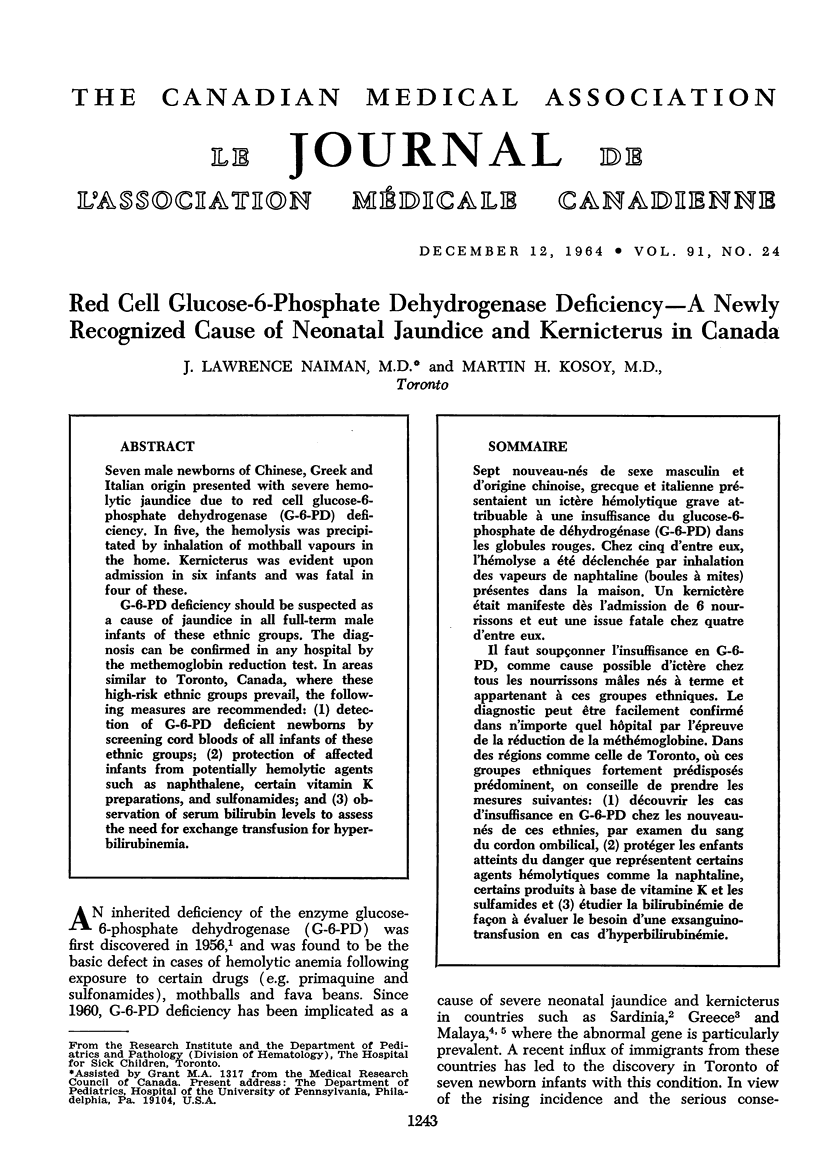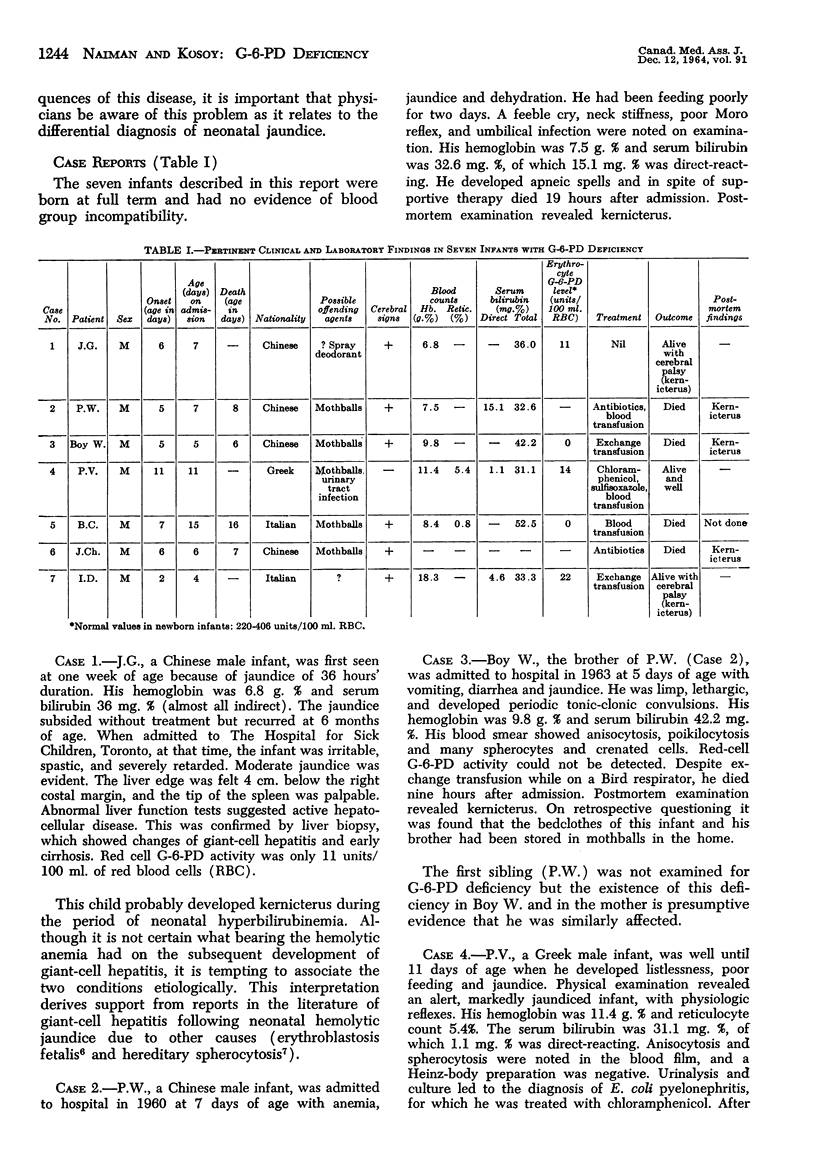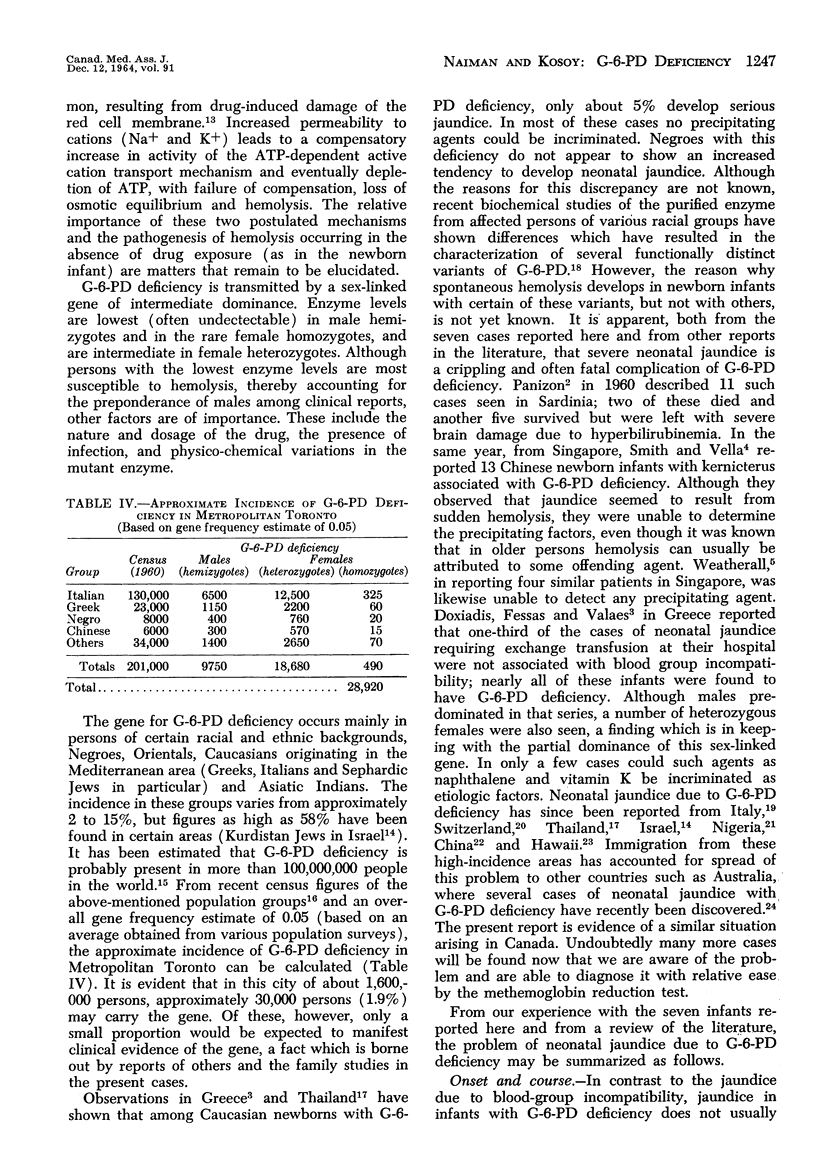Abstract
Seven male newborns of Chinese, Greek and Italian origin presented with severe hemolytic jaundice due to red cell glucose-6-phosphate dehydrogenase (G-6-PD) deficiency. In five, the hemolysis was precipitated by inhalation of mothball vapours in the home. Kernicterus was evident upon admission in six infants and was fatal in four of these.
G-6-PD deficiency should be suspected as a cause of jaundice in all full-term male infants of these ethnic groups. The diagnosis can be confirmed in any hospital by the methemoglobin reduction test. In areas similar to Toronto, Canada, where these high-risk ethnic groups prevail, the following measures are recommended: (1) detection of G-6-PD deficient newborns by screening cord bloods of all infants of these ethnic groups; (2) protection of affected infants from potentially hemolytic agents such as naphthalene, certain vitamin K preparations, and sulfonamides; and (3) observation of serum bilirubin levels to assess the need for exchange transfusion for hyperbilirubinemia.
Full text
PDF






Images in this article
Selected References
These references are in PubMed. This may not be the complete list of references from this article.
- ALVING A. S., CARSON P. E., FLANAGAN C. L., ICKES C. E. Enzymatic deficiency in primaquine-sensitive erythrocytes. Science. 1956 Sep 14;124(3220):484–485. doi: 10.1126/science.124.3220.484-a. [DOI] [PubMed] [Google Scholar]
- BAIN G. O., WANG G. C., MISANIK L. F. Giant cell hepatitis associated with hereditary spherocytosis. J Pediatr. 1957 Nov;51(5):549–553. doi: 10.1016/s0022-3476(57)80072-9. [DOI] [PubMed] [Google Scholar]
- BREWER G. J., TARLOV A. R., ALVING A. S. The methemoglobin reduction test for primaquine-type sensitivity of erythrocytes. A simplified procedure for detecting a specific hypersusceptibility to drug hemolysis. JAMA. 1962 May 5;180:386–388. doi: 10.1001/jama.1962.03050180032008. [DOI] [PubMed] [Google Scholar]
- CAPPS F. P., GILLES H. M., JOLLY H., WORLLEDGE S. M. GLUCOSE-6-PHOSPHATE DEHYDROGENASE DEFICIENCY AND NEONATAL JAUNDICE IN NIGERIA: THEIR RELATION TO THE USE OF PROPHYLACTIC VITAMIN K. Lancet. 1963 Aug 24;2(7304):379–383. doi: 10.1016/s0140-6736(63)93059-9. [DOI] [PubMed] [Google Scholar]
- CARSON P. E., TARLOV A. R. Biochemistry of hemolysis. Annu Rev Med. 1962;13:105–126. doi: 10.1146/annurev.me.13.020162.000541. [DOI] [PubMed] [Google Scholar]
- COHEN G., HOCHSTEIN P. GLUTATHIONE PEROXIDASE: THE PRIMARY AGENT FOR THE ELIMINATION OF HYDROGEN PEROXIDE IN ERYTHROCYTES. Biochemistry. 1963 Nov-Dec;2:1420–1428. doi: 10.1021/bi00906a038. [DOI] [PubMed] [Google Scholar]
- DOXIADIS S. A., FESSAS P., VALAES T. Glucose-6-phosphate dehydrogenase deficiency. A new aetiological factor of severe neonatal jaundice. Lancet. 1961 Feb 11;1(7172):297–301. doi: 10.1016/s0140-6736(61)91476-3. [DOI] [PubMed] [Google Scholar]
- GABURRO D., VOLPATO S., SCARPA P. [Neonatal erythrocytic pathology caused by glucose-6-phosphate dehydrogenase deficiency]. Ann Pediatr (Paris) 1962 Dec 2;9:625–627. [PubMed] [Google Scholar]
- HARLEY J. D., ROBIN H. "Late" neonatal jaundice in infants with glucose-6-phosphate dehydrogenase-deficient erythrocytes. Australas Ann Med. 1962 Aug;11:148–155. doi: 10.1111/imj.1962.11.3.148. [DOI] [PubMed] [Google Scholar]
- HARLEY J. D., ROBIN H. Haemolytic activity of vitamin K3: evidence for a direct effect on cellular enzymes. Nature. 1962 Feb 3;193:478–481. doi: 10.1038/193478a0. [DOI] [PubMed] [Google Scholar]
- MOHLER D. N., CROCKETT C. L., Jr HEREDITARY HEMOLYTIC DISEASE SECONDARY TO GLUCOSE-6-PHOSPHATE DEHYDROGENASE DEFICIENCY: REPORT OF THREE CASES WITH SPECIAL EMPHASIS ON ATP METABOLISM. Blood. 1964 Apr;23:427–444. [PubMed] [Google Scholar]
- NEWMAN A. J., GROSS S. HYPERBILIRUBINEMIA IN BREAST-FED INFANTS. Pediatrics. 1963 Dec;32:995–1001. [PubMed] [Google Scholar]
- PANIZON F. [Icterus gravis neonatorum associated with a deficiency in glucose-6-phosphate dehydrogenase]. Biol Neonat. 1960 Oct;2:167–177. [PubMed] [Google Scholar]
- SCHAERER K., HERZKA H., MARTI H. R. KERNICTERUS BEI MANGEL AN GLUKOSE-6-PHOSPHAT-DEHYDROGENASE DER ERYTHROCYTEN. Helv Paediatr Acta. 1963 Aug;18:148–162. [PubMed] [Google Scholar]
- SZEINBERG A., OLIVER M., SCHMIDT R., ADAM A., SHEBA C. Glucose-6-phosphate dehydrogenase deficiency and haemolytic disease of the newborn in Israel. Arch Dis Child. 1963 Feb;38:23–28. doi: 10.1136/adc.38.197.23. [DOI] [PMC free article] [PubMed] [Google Scholar]
- TARLOV A. R., BREWER G. J., CARSON P. E., ALVING A. S. Primaquine sensitivity. Glucose-6-phosphate dehydrogenase deficiency: an inborn error of metabolism of medical and biological significance. Arch Intern Med. 1962 Feb;109:209–234. doi: 10.1001/archinte.1962.03620140081013. [DOI] [PubMed] [Google Scholar]
- VALAES T., DOXIADIS S. A., FESSAS P. ACUTE HEMOLYSIS DUE TO NAPHTHALENE INHALATION. J Pediatr. 1963 Nov;63:904–915. doi: 10.1016/s0022-3476(63)80221-8. [DOI] [PubMed] [Google Scholar]
- ZINKHAM W. H. An in-vitro abnormality of glutathione metabolism in erythrocytes from normal newborns: mechanism and clinical significance. Pediatrics. 1959 Jan;23(1 Pt 1):18–32. [PubMed] [Google Scholar]
- ZINKHAM W. H. Peripheral blood and bilirubin values in normal full-term primaquine-sensitive Negro infants: effect of vitamin K. Pediatrics. 1963 Jun;31:983–995. [PubMed] [Google Scholar]



